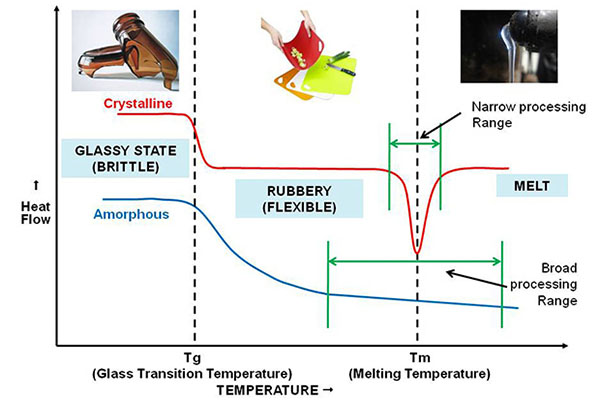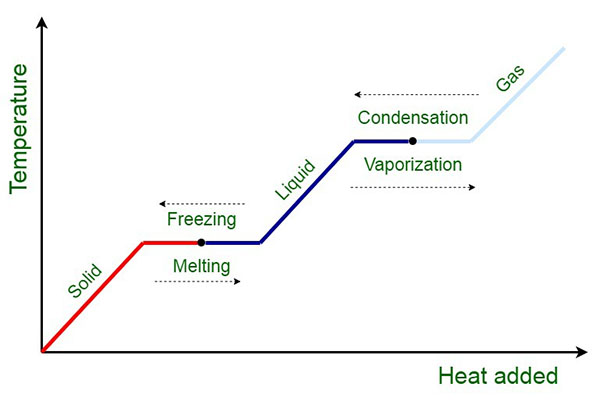Tg and Tm for Plastic Injection Molding
Tm represents the temperature at which the crystalline portions of the semi-crystalline polymer begin to flow. Unlike amorphous polymers that undergo a glass transition, semi-crystalline polymers exhibit a gradual softening above their Tg but do not fully behave like a fluid until they reach their Tm.
Tg and its influencing/affected factors are examined in this article. Also, you will study the distinctions between glass transition temperature (Tg) and melting point (Tm), two thermal characteristics of polymers that are not the same.
At Sungplastic, our designers and engineers are very familiar with Tg and Tm in plastic injection molding process, and we can answer your questions in this regard about Tg and Tm or other injection molding aspects.
Glass Transition and Thermoplastics
The concept of the glass transition pertains to the reversible alteration of physical characteristics in certain materials, particularly thermoplastics, when they experience specific temperature variations, either through heating or cooling. These materials, at low temperatures, exhibit a brittle nature but transform into a ductile state as they reach their glass transition temperature during heating.
To illustrate this, consider the distinction between the solid, rigid plastic pellets introduced into the hopper of an injection molding machine and the molten plastic material that enters the injection mold. The plastic pellets remain solid and inflexible, while the molten material adopts a semi-flexible, rubbery consistency.
The glass transition temperature (Tg) marks the temperature at which a polymer initiates this transformation. Based on their molecular structure, thermoplastics employed in injection molding typically fall into two primary categories:
- Amorphous plastics possess a disorganized molecular structure devoid of crystalline regions. Examples include PS, PC, PSU, and PVC.
- Semicrystalline plastics exhibit a semi-ordered molecular structure, with ordered crystalline regions interspersed among disordered amorphous sections. Examples include PE, PET, PTFE, and PP.
It is important to note that the glass transition temperature is associated with the material’s processing but is distinct from its melting point.

Difference Between Tg and Tm
Glass transition temperature (Tg) and melting point (Tm) represent two separate temperature-related phenomena characterizing the behavior of polymers.
Tg describes the transition of amorphous plastics or the amorphous portion of semi-crystalline plastics from a rigid, glass-like state to a more flexible, rubbery state.
Tm, on the other hand, refers to the critical temperature at which the crystalline regions in semi-crystalline plastics change from a solid to a viscous liquid state.
Semi-crystalline plastics gradually soften above Tg; however, they do not exhibit true fluid behavior until they approach the Tm range.
In general, the melting point (Tm) of semi-crystalline plastics is higher than their glass transition (Tg) temperature. The temperature differential between Tg and Tm is often referred to as the “rubbery region” because a plastic that reaches Tg adopts a rubber-like consistency.
Below listed is the Tg (°C) for some plastic injection molding materials.
General Purpose Polystyrene (GPPS): 100°C
High Density Polyethylene (HDPE): -120°C
Liquid Crystal Polymer(LCP): 120°C
Liquid Silicone Rubber (LSR): -125°C
Polycarbonate(PC): 145°C
Polyetheretherketone (PEEK): 140°C
Polyetherimide(PEI): 210°C
Polymethyl methacrylate (PMMA): 90°C
Polypropylene (atactic)(PP): -20°C
Polyphenylene sulfone (PPSU): 90°C
Polysulfone (PSU): 190°C
Syndiotactic Polystyrene (SPS): 100°C

Why is Tg Significant in Plastic Injection Molding?
The importance of glass transition temperature (Tg) in injection molding can be attributed to four key factors:
Mechanical Properties: Polymers exhibit limited flexibility below Tg, but above Tg, they can deform without fracturing, facilitating the injection molding process.
Processing Temperatures: Elevating the polymer’s temperature above its Tg enables it to flow and conform to the shape of the mold, aiding in the manufacturing process.
Material Selection: Choosing a thermoplastic with an appropriate Tg ensures that it maintains its properties while enduring the temperatures encountered in the application.
Physical Properties: Tg has a bearing on physical attributes such as thermal expansion, electrical conductivity, and optical transparency in the final molded products.
What Factors Influence the Tg of Polymers?
Several factors can influence the glass transition temperature (Tg) of polymers, including:
Molecular Structure: Polymers with flexible molecular chains, like polyethylene, tend to have lower Tg values, while those with rigid and inflexible structures, such as polycarbonate, exhibit higher Tg values.
Molecular Weight: Generally, higher molecular weight polymers have higher Tg values. Greater molecular weight results in stronger intermolecular forces due to increased entanglements and interactions between polymer chains.
Presence of Plasticizers: Plasticizers interact with polymer chains, reducing intermolecular forces and increasing molecular mobility, thereby lowering the Tg of the polymer and enhancing flexibility.
Thermal History: The rate at which polymers are cooled from a molten state can impact their Tg values. Rapidly cooled polymers may have different Tg values than slowly cooled or unprocessed polymers.
Chemical Cross-Linking: Cross-linking restricts molecular motion and raises the Tg. As the degree of cross-linking increases, the polymer becomes more rigid, and Tg increases correspondingly.
Crystallinity: Crystallinity hinders the movement of polymer chains and contributes to a higher Tg. In semi-crystalline polymers, the proportion and arrangement of amorphous and crystalline regions collectively influence the overall Tg.
Plastic Injection Molding at Sungplastic
A material scientist is not necessary to be successful with plastic injection molding. Glass transition temperature (Tg) impacts everything from post-molded qualities like thermal conductivity and optical clarity to production conditions and cooling periods, therefore it’s crucial for part designers to understand Tg.
We can assist you in choosing the ideal material for your project based on a variety of factors to ensure the greatest outcomes. Our team comprises highly skilled injection molders who have vast experience in handling diverse materials for a multitude of uses. Our professionals can assist in choosing the right materials and offer in-depth DFM analysis to make sure your designs are injection molding ready. From conception to creation, prototype to manufacturing, we offer comprehensive services under one roof.
If you are interested in it or confused, welcome to communicate with our experts.
Get a free quote and design analysis today.
We’ll reply to you within 6 working hours.
We respect your privacy.
+86 139 2927 4777 (WhatsApp, Wechat)
